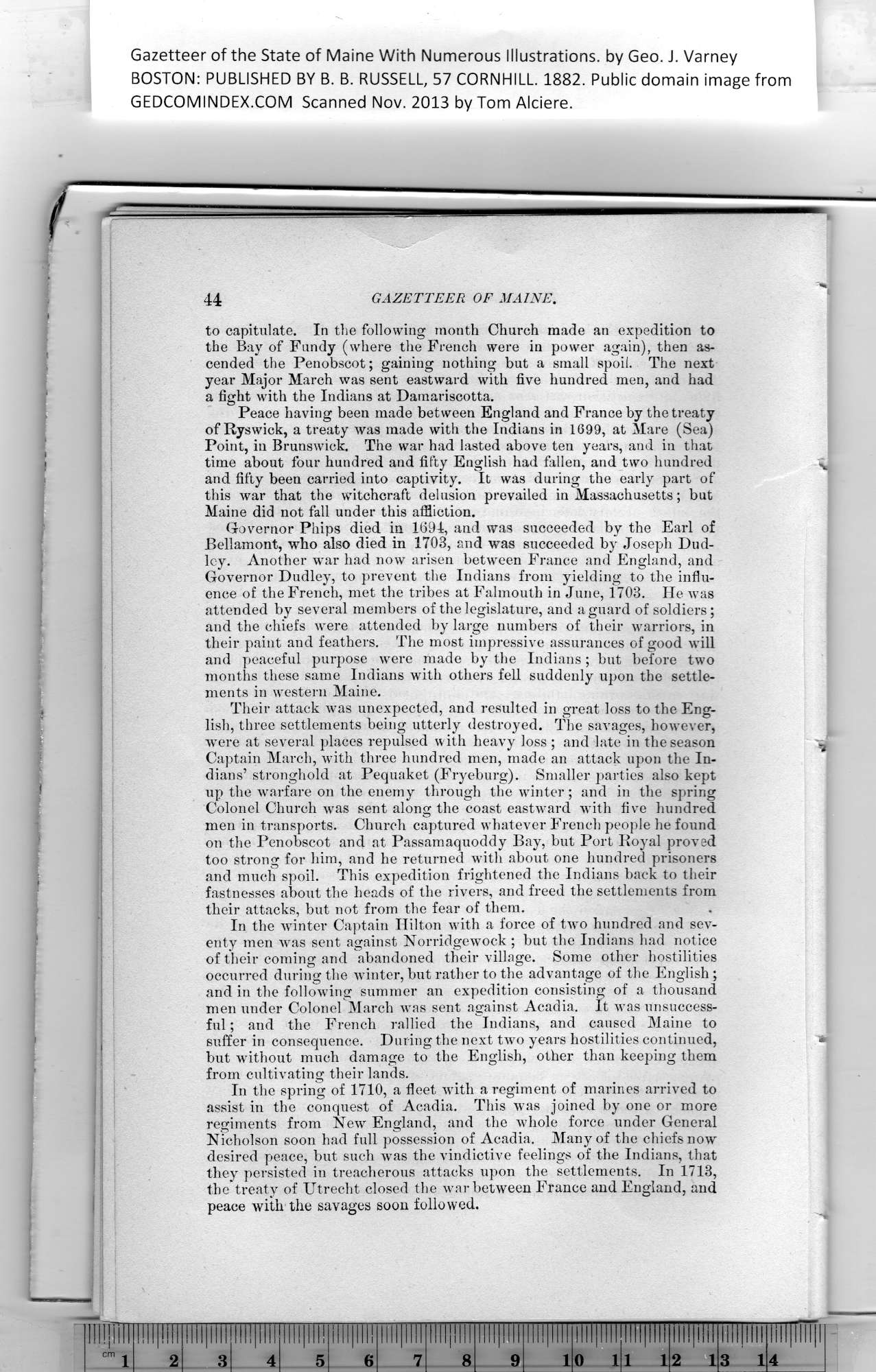|
Gazetteer of the State of Maine With Numerous Illustrations, by Geo. J. Varney
BOSTON: PUBLISHED BY B. B. RUSSELL, 57 CORNHILL. 1882. Public domain image from
44 GAZETTEER OF MAINE.
to capitulate. In the following month Church made an expedition to
the Bay of Fundy (where the French were in power again), then as-
cended the Penobscot; gaining nothing but a small spoil. The next
year Major March was sent eastward with five hundred men, and had
a fight with the Indians at Damariscotta.
Peace having been made between England and France by the treaty
of Ryswick, a treaty was made with the Indians in 1699, at Mare (Sea)
Point, in Brunswick. The war had lasted above ten years, and in that
time about four hundred and fifty English had fallen, and two hundred
and fifty been carried into captivity. It was during the early part of
this war that the witchcraft delusion prevailed in Massachusetts; but
Maine did not fall under this affliction.
Governor Phips died in 1691, and was succeeded by the Earl of
Bellamont, who also died in 1703, and was succeeded by Joseph Dud-
ley. Another w'ar had now arisen between France and England, and
Governor Dudley, to prevent the Indians from yielding to the influ-
ence of the French, met the tribes at Falmouth in June, 1703. He was
attended by several members of the legislature, and a guard of soldiers;
and the chiefs were attended by large numbers of their warriors, in
their paint and feathers. The most impressive assurances of good will
and peaceful purpose were made by the Indians; hut before two
months these same Indians with others fell suddenly upon the settle-
ments in western Maine.
Their attack was unexpected, and resulted in great loss to the Eng-
lish, three settlements being utterly destroyed. The savages, however,
were at several places repulsed with heavy loss ; and late in the season
Captain March, with three hundred men, made an attack upon the In-
dians’ stronghold at Pequaket (Fryeburg). Smaller parties also kept
up the warfare on the enemy through the winter; and in the spring
Colonel Church was sent along the coast eastward with five hundred
men in transports. Church captured whatever French people he found
on the Penobscot and at Passamaquoddy Bay, but Port Royal proved
too strong for him, and he returned with about one hundred prisoners
and much spoil. This expedition frightened the Indians hack to their
fastnesses about the heads of the rivers, and freed the settlements from
their attacks, but uot from the fear of them.
In the winter Captain Hilton with a force of two hundred and sev-
enty men was sent against Norridgewock ; but the Indians had notice
of their coming and "abandoned their village. Some other hostilities
occurred during the winter, but rather to the advantage of the English;
and in the following summer an expedition consisting of a thousand
men under Colonel March was sent against Acadia. It was unsuccess-
ful ; and the French rallied the Indians, and caused Maine to
suffer in consequence. During the next two years hostilities continued,
but without much damage to the English, other than keeping them
from cultivating their lands.
In the spring of 1710, a fleet with a regiment of marines arrived to
assist in the conquest of Acadia. This was joined by one or more
regiments from New England, and the whole force under General
Nicholson soon had full possession of Acadia. Many of the chiefs now
desired peace, but such was the vindictive feelings of the Indians, that
they persisted in treacherous attacks upon the settlements. In 1713,
the treaty of Utrecht closed the war between France and England, and
peace with the savages soon followed.
PREVIOUS PAGE ... NEXT PAGE
This page was written in HTML using a program written in Python 3.2
|
